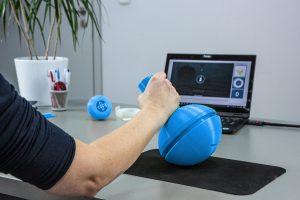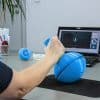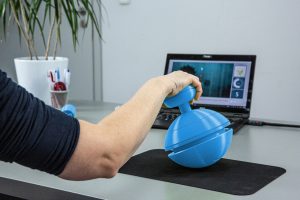
Hand Therapy Gaming Device Webinar: How to Drive Patient Engagement with Capri
Treatment GuidelinesExplore the world of fun, effective, and evidence-based therapeutic gaming devices like you've never seen before. Discover how engaging exercises promote neuroplasticity and transform your hand therapy practice, featuring Q&A from our recent webinar with ASHT.
We recently presented a webinar to explore the topic of hand therapy gaming devices and their impact on patient engagement in physical therapy and occupational therapy. In addition to learning about innovative rehabilitation equipment, this session was also an opportunity for attendees to see a demonstration of BTE’s latest hand therapy tool, the Capri.
During the session, we received some thought-provoking questions from attendees, highlighting the growing interest in how these innovative hand therapy tools can transform the patient experience and enhance clinical outcomes. In this article, we’ll delve into some of the key questions asked during the webinar and explore how hand therapy gaming devices like Capri benefit physical therapy, occupational therapy, neurological rehab, and boost patient engagement.
Presented in collaboration with the American Society of Hand Therapists, this webinar is available to watch on-demand for a limited time. Watch the full webinar below, and keep reading for our Q&A discussion.
Hand Therapy Gaming Device Webinar: Presented by BTE and ASHT
Benefits of Hand Therapy Gaming Devices for Physical Therapy and Occupational Therapy
The concept of gamified hand therapy has been around for decades.1 However, in this article, we’re talking about video game devices that are specifically designed for hand therapy. In the world of hand therapy tools, video-game-based devices offer all the benefits of hand therapy exercises with additional neuromuscular involvement for a highly engaging treatment experience. Specifically, they make the all-important repetitive motions more fun, build fine motor skills, improve coordination, and promote neuroplasticity to support recovery. If used properly, therapeutic gaming devices can augment your patients’ physical therapy and occupational therapy outcomes.
Repetitive Hand Therapy Exercises Made Fun
In hand therapy, patients often complain about repetitive motions. With therapeutic gaming devices, you can transform repetitive exercises into a fun and engaging gaming session. While playing the game, patients still repeat specific movements, but without the tedium that traditional exercises can induce. Further, research shows that patients who have fun in their therapy sessions are better able to tolerate the repetitive exercises.2 This repetition within an engaging context keeps patients motivated while effectively promoting recovery.
Building Fine Motor Skills and Coordination
Many hand therapy gaming devices focus on functional tasks that require precise movements, aiming, dexterity, and motor control. These devices often involve targeting specific points on the screen, steering towards objects, avoiding obstacles, or otherwise manipulating objects with precision.
Visual feedback within the games reinforces hand-eye coordination, allowing patients to experience the immediate effects of their movements and adjust. This real-time sensory feedback is necessary for fine-tuning those motor skills. Eventually, these therapeutic games help patients regain their ability to perform everyday tasks independently.
How Does Therapeutic Gaming Benefit Physical Therapy?
Specific to physical therapy, therapeutic gaming devices are an innovative way to support restoration of movement, strength, and coordination. Patients recovering from upper extremity injuries or surgery can regain foundational motor skills quickly with greater engagement. Designed to facilitate repetitive, functional movement, these treatment devices enable your patients to practice essential motions that rebuild gross and fine motor skills.
For example, therapeutic video games can challenge finger extension, grip strength, wrist movement, forearm rotation, and many other upper extremity movements. By promoting these movements in a safe, controlled environment, therapeutic gaming devices can help your patients regain strength, range of motion, and endurance.
How Does Therapeutic Gaming Benefit Occupational Therapy?
Although very similar to the goals and treatment approaches in physical therapy, therapeutic gaming plays a distinct role in occupational therapy. In occupational therapy, therapeutic gaming devices are valuable tools for building fine motor skills, hand-eye coordination, and cognitive function. The repetitive, task-oriented movements in a game enhance skill retention and learning, which are crucial for patients recovering from neurological conditions, injuries, or surgery.
Therapeutic gaming addresses the cognitive aspects central to OT’s holistic approach, as many games require problem-solving, decision-making, sequencing movements, or responding to visual cues. The cognitive component strengthens executive functions and reaction times, blending physical engagement to help patients regain their functional abilities.
What Hand Therapy Exercises Can Patients Do with Capri?
Capri’s hand therapy gaming facilitates several wrist exercises:
- Supination, pronation
- Flexion, extension
- Radial, ulnar deviation
- Isolated or combined movements
These gamified hand therapy exercises help patients increase strength, range of motion, and neuromuscular control to regain daily functions. Customizable settings allow the hand therapist to limit or increase the range or motion, depending on the patient’s abilities. Each exercise can be performed with any of the three different grip styles for an exercise variety that challenges and engages patients in each session.
Hand Therapy Gaming Exercises with Capri
How Hand Therapy Gaming Devices Aid Neurologic Rehabilitation
Hand therapy gaming devices are excellent tools for neurologic rehabilitation, thanks to their ability to promote neuroplasticity, enhance motor control, and improve coordination and proprioception. Let’s break down each of these benefits:
- Neuroplasticity: First and foremost, therapeutic gaming promotes neuroplasticity and learning. With repetitive and task-specific actions, therapeutic gaming helps form and reinforce new neural connections, especially after a neurologic injury or event. Immediate feedback plus the increasing difficulty levels creates the ideal environment for neuroplastic changes. Patients are essentially training their brains to rewire and adapt, promoting both cognitive and physical recovery.
- Motor control: Secondly, gaming is very effective at training motor control. Neurorehab requires re-teaching the body how to do precise, controlled movements and video games require exactly that. These games require fine motor skills, hand-eye coordination, and gross motor tasks that provide a progressive challenge. The repetitive practice helps patients regain control over their movements while motivating them to reach higher levels.
- Coordination: In addition to motor control, gaming also plays a key role in improving coordination. Whether bilateral hand coordination or integrating visual and motor tasks, video games can demand complex, coordinated movements. This focus on coordination helps patients rebuild the ability to synchronize movements.
- Proprioception: Therapeutic video games can help improve proprioception, the body’s awareness of its position and movement in space. Many games require spatial awareness, joint positioning, neuromuscular control, and movement accuracy. These skills may have been impaired in a neurological injury, and improvement in these areas can translate to better balance, stability, and confidence.
What Clinical Research Supports Therapeutic Gaming Devices for Neurological Rehabilitation?
With a body of published clinical evidence, therapeutic gaming devices are indeed an evidence-based practice. Recent research shows promising results for patients recovering from stroke, Parkinson’s disease, and TBI. More on each of these studies:
- Stroke: Stroke survivors were randomly assigned to either traditional physical therapy treatment or therapeutic gaming treatment. After four weeks, the therapeutic gaming group saw improvement in balance, functional performance, and ADLs.3
- Parkinson’s: Numerous clinical studies support the use of therapeutic gaming devices for Parkinson’s rehabilitation. A systematic review of several such studies shows positive improvement in motor skills, cognitive function, balance, gait, and most importantly, transferring these skills to real-life tasks. 4,5
- Traumatic Brain Injury (TBI): Patients with TBI experienced increased motivation with the use of therapeutic gaming devices, which led to increased attention and greater engagement during therapy sessions.6
Can the Capri Help Neurological Conditions like Parkinson’s?
The Capri is designed to benefit several neurological conditions, including Parkinson’s. Each therapeutic game can be customized to appropriately challenge patients and promote several key aspects of Parkinson’s rehab, including:
- Neuroplasticity
- Neuromuscular control
- Fine motor skills
- Upper limb coordination
- Proprioception
Because Parkinson’s rehab must address a wide range of capabilities, limitations, and goals, it is important to tailor each game to each of your patients. With the Capri, you can make changes to both the physical device itself and the game settings for a personalized Parkinson’s treatment session. You can choose from three grip styles, use the optional stability straps for patients with limited gripping abilities, and use the optional ROM limiters to isolate a single plane of motion (isolate either vertical movement only or horizontal movement only) or allow for 2D movement in any direction. Within the game settings, you may change the ROM, change the speed at which the game progresses (increase or decrease required reaction times), add or remove obstacles, and many other customizable difficulty settings.
How to Enhance Patient Engagement with Therapeutic Gaming Devices
One of the most important benefits of therapeutic gaming devices is their impact on patient engagement. Countless studies show that therapeutic gaming devices increase patient engagement, which leads to better clinical outcomes. One study analyzed data from several research articles about the use of gaming devices in healthcare. The results show that therapeutic gaming devices improved 59% of physical therapy outcomes, 42% of health education outcomes, 42% of pain distraction outcomes, and 37% of disease self-management outcomes.7
These devices transform repetitive exercises into fun and interactive experiences, motivating patients to actively participate in rehabilitation sessions. This is especially true for therapeutic gaming devices that provide real-time visual feedback. Gamified physical therapy and occupational therapy sessions are more enjoyable, as patients focus on learning the game and getting higher scores while feeling a sense of accomplishment.
How Does Therapeutic Gaming Keep Patients Engaged for Long-Term Cases?
We all know that compliance can be a major hurdle, but gaming offers something different. Patients can see their progress and have lots of fun while doing it, which keeps them coming back. This active engagement helps reduce dropouts and improve long-term outcomes. Therapeutic games that have customizable difficulty settings can keep patients engaged for a longer time, adapting to each person’s development.
How Can I Increase the Difficulty to Challenge Patients Over Time?
The Capri was designed with patient engagement in mind. Even through a long recovery process, the Capri can keep patients engaged and challenge them as they progress. You can adjust each game’s movement requirements and difficulty to adapt with your patients in a variety of ways:
- Change handles for a different grip
- Large open-palm
- Small open-palm
- Joystick
- Movement pattern
- Isolated supination-pronation or flexion-extension
- Bidirectional movement (supination-pronation and flexion-extension)
- Increase or decrease range of motion in any direction
- Difficulty settings within each game
- Increase or decrease game sensitivity for fine motor control
- Increase or decrease required reaction time
- Increase or decrease the number of obstacles, required points, action complexity, speed, etc.
How to Use the Capri Hand Therapy Gaming Device for Rehabilitation Treatment, Progress Reports, and Engagement
The Capri hand therapy gaming device is an excellent clinical tool for physical therapy, occupational therapy, and neurologic rehabilitation. The fun, interactive games keep patients engaged while addressing proprioception, coordination, neuromuscular control, strength, and range of motion.
What Orthopedic Conditions Does Capri Address?
The Capri can address several orthopedic or musculoskeletal conditions, including:
- Hand or digit injuries
- Orthopedic surgery rehab
- Hand surgery rehab
- Musculoskeletal disorders
- Limited ROM
What Conditions in Neurological Rehab Can the Capri Treat?
The Capri can address many neurologic conditions, including:
- Multiple sclerosis (MS)
- Stroke
- Traumatic brain injury (TBI)
- Spinal cord injury
- Brain tumor
- Parkinson’s Disease
- Cerebral palsy
- Amyotrophic lateral sclerosis (ALS)
- Paralysis due to hernia
Can Capri’s Hand Therapy Games be Used in Early-Stage Injury Recovery?
Yes, you can use the Capri for early intervention in injury or surgery recovery. Between the device itself and the game setting, you have many exercise modification options to make it safer, easier, or gentler for your patients. For example, attaching the rails to the bottom of the Capri will limit the movement to only one direction and prevent the patient from moving any other direction. Remove these rails to challenge the patient to stabilize the movement themselves. The stability strap is another way to stabilize patients using the Capri. Other early intervention options include simple, single-directional games that allow the patient to practice small, gentle movements in a controlled manner.
Can Capri Games Help with Cognitive Functions Like Recall?
Yes, neurological rehabilitation games included in the Capri can address cognitive functions. For example, the matching game requires the patient to recall the shape and/or color previously shown and match it to the shape currently shown using a simple wrist movement. Early in rehab, you can allow the maximum amount of time to complete the task. As the patient progresses, you can change the game settings to increase the demand on the patient’s reaction time and recall skills.
Can Capri Be Used in Home Health?
Yes, the Capri is lightweight and portable, so clinicians may take it with them for home health visits. You can use it on any flat tabletop surface with a chair for the patient to sit on during use. Using the Capri during home visits is a great way to boost engagement and provide fun, clinically advanced exercise outside the clinic.
Is Gaming with Capri Reimbursed by Health Insurance?
Yes, the hand therapy games with Capri qualify for reimbursement under the following CPT codes:
- CPT 97112 Neuromuscular Reeducation
- CPT 97530 Therapeutic Activity
- CPT 97110 Therapeutic Exercise
Hand Therapy Gaming Devices in the Clinic
Evidence-based gaming devices can take your hand therapy practice to the next level. These treatment tools create better outcomes for patients by keeping them engaged and motivated throughout their recovery process. Whether your clinic specializes in hand therapy, neurological rehab, or treats a broad range of physical therapy and occupational therapy patients, therapeutic gaming has something to offer. The benefits of improving proprioception, motor control, and neuroplasticity carry over to improve overall health.
Leveraging these benefits, the Capri is BTE’s latest development in hand therapy technology. With 10 games to choose from and customizable grips, movement styles, and difficulty settings, the Capri’s hand therapy gaming is fun, engaging, and evidence-based. Contact us to learn more about the Capri and get a quote for your clinic.
Contact Us




